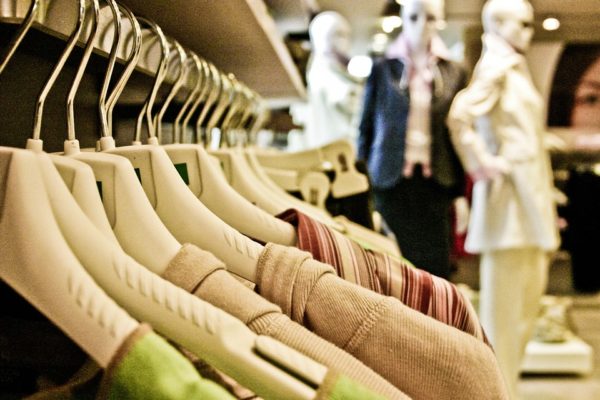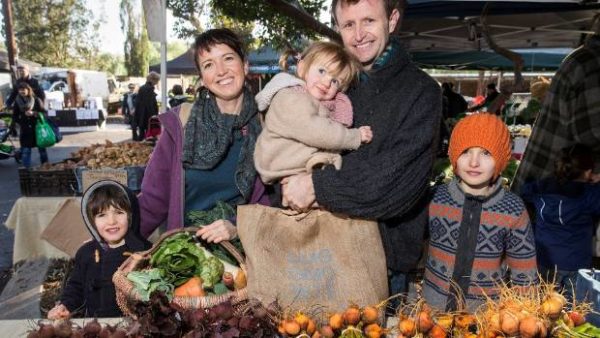Melbourne physiotherapist Lauren Dircks and her husband Andrew Casey began their ethical shopping journey when they had their first child nine years ago.
The couple had already done a six-month course on sustainable living and saw an opportunity to make food choices that aligned their environmental principles with better health.
“It was about making different choices and how you can take little steps to be a better global citizen,” Lauren says.
Lauren Dircks, Andrew Casey and their three children Gus 5 (left), Emiliana 2 and Owen 9 at the Abbotsford Convent farmer’s market.
They started buying local organic fruit and vegetables through Australia’s CERES Fair Food system, also acting as a host for many years.
“Then that led to going and revisiting farmers’ markets as a legitimate way of doing weekly shopping,” she adds.
Along the way they’ve ditched heavily packaged items and they make a habit of buying second-hand clothing and preloved presents for their three children.
They also question what lower prices mean.
“A T-shirt that costs A$2 means someone somewhere hasn’t been fairly paid. Likewise, a A$1 loaf of bread or litre of milk,” says Lauren.
She admits there can be challenges, such as when her nine-year-old son wants to spend gift money on something plastic from a A$2 shop.
But she’s heartened by the number of people willing to engage with such issues.
“They are all at different stages but it’s gaining momentum and I think that’s a really exciting thing – if we’re all working towards that individually then we’ll see a bigger change.”
Like Lauren, a growing number of people are making choices to consume with their eyes wide open.
In 2015 global research by Nielsen showed “significant increases in the number of consumers who say that they want products from sustainable companies and they are willing to spend more to get them” in the past two years.
It found commitment to the environment has the power to sway product purchase for 45 per cent of consumers surveyed. Commitment to social value (43 per cent) and the consumer’s community (41 per cent) are also important purchase drivers.
There are plenty of apps and public campaigns to guide people wanting to make more ethical shopping choices.
Australia’s Shop Ethical produced its first print guide seven years ago and its first app five years ago. Shop Ethical’s Nick Ray says to date about 140,000 people have bought the print guide.
He suggests people start by looking at the key issues attached to the products they are already buying.
“The product label is the place to start. So for example, country of origin labelling talks about where the item is transformed or put together and also often it’s connected to where ingredients come from but people often don’t really get the complexities of that,” he says.
“You try to make ethical decisions where you’re at and you build on the information you had before,” he suggests.
Thinking about where we shop is important, too.
“If I go to a food co-op they’ve done some of the hard work for me or a local grocer that I can talk to instead of a check-out person.”
Other information sources include Greenpeace consumer guides on palm oil; canned tuna and sustainable seafood; and Choice campaigns on free-range eggs and palm oil.
In April, Choice launched an app for consumers to use in the supermarket so they can identify “free range” eggs from hens stocked at 1500 hens per hectare rather than 10,000 hens per hectare.

CONSUMERS DRIVE CHANGE
As consumers vote with their wallets companies are forced to change. Baptist World Aid Australia produces the annual Australian Fashion Report, which grades 308 fashion brands on the systems they have in place to protect the workers in their supply chain from exploitation, forced labour and child labour.
Baptist World Aid Australia advocacy manager Gershon Nimbalker says consumers can actively choose companies that are doing more to protect their workers, and write to those they are boycotting.
“Consumers have a lot of power to drive change and we’ve seen that increasingly through company responses,” he says.
“The worst labour rights abuses usually occur where facilities, factories and farms are unknown by the companies therefore they are unmonitored.”
Since it released its first report in 2013 the proportion of companies tracing their supply chain to that second tier has risen from 48 per cent to 78 per cent.
“The amount of companies that are paying living wages or at least monitoring to see whether they are paying wages significantly above the minimum has substantially increased as well,” he adds.
The perception that it will cost more to stand by their values can discourage people, according to Queensland University of Technology (QUT) Business School senior lecturer marketing Gary Mortimer.
“Often that tends to be one of the big barriers between intentions and behaviours – this perception that it’s going to cost me a lot more money if I buy a sustainably produced product or a more locally produced food product,” he says.
Greenwashing is also alive and well as companies see the potential in appealing to ethical consumers.
Tanya Ha, author of book Greeniology, suggests it’s important to stay alert to advertiser claims that can’t be specifically tested. For instance, cosmetics labelled “100 percent natural” or “clinically proven”.
Another rule of thumb is to ask whether cheap prices really reflect the value that would have gone into making the product, she suggests.
Source: Stuff
Women of Green is TURNING UP THE VOLUME of the feminine voice on the planet in order to create the world we know is possible.
